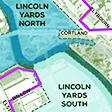The city of Chicago has released documents that would, if the City Council approves, turn plans for the Lincoln Yards development into law—but legally sidestep many of the details released to the public.
Inside Chicago Government has obtained two proposed city ordinances—one each for Lincoln Yards North and Lincoln Yards South—after they were approved by the Chicago Plan Commission at its Jan. 24 meeting.
Lincoln Yards, a 54-acre residential, office, and retail complex proposed by developer Sterling Bay, would straddle the Chicago River's North Branch, north and south of Cortland St.
Each of the proposed ordinances is based on a city-required document filed by developer Sterling Bay: what the city calls an "application for planned development." Any construction that fits the city's definition of a planned development, or PD, requires its developer to submit a highly detailed application.
Lincoln Yards meets the city's definition of a PD because it's near a waterway (the Chicago River), and because the developer wants to boost the available floor space far beyond that of the land's previous industrial occupants.
One way that the city keeps developers from constructing buildings that are too big or too dense is via zoning: Each parcel of land in Chicago has a zoning classification that limits the size and use of the buildings on the property.
Because it's not uncommon that a planned development changes the size and use of what was previously on the property, a PD almost always involves a zoning change—codified in a city ordinance called a zoning map amendment.
For most PDs, the Chicago Dept. of Planning and Development has a standard application that it requires developers to complete. According to a planning department manual available to developers, a PD application requires lots of detail: building heights, square footage, quantity of residential units, site drawings, and more—which, the department claims, undergo rigorous scrutiny by city staff.
However, the city's own records show that Sterling Bay's original PD documents—contained in a proposed zoning-change ordinance for each of Lincoln Yards North and Lincoln Yards South filed with the city council on July 25, 2018—hold far less detail than the versions approved on Jan. 24 by the city's Plan Commission. The city's planning department would not provide documents that explain the discrepancy, and would not disclose Sterling Bay's actual PD applications for Lincoln Yards. But, a spokesperson said, the department found no deficiencies in Sterling Bay's original applications.
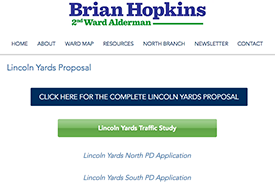
Page from the Web site of Ald. Brian Hopkins (2nd), showing
links to Lincoln Yards planned development applications.
Source: aldermanhopkins.com
Adding to the opacity, the Web site of Ald. Brian Hopkins contains links to what it calls the "Lincoln Yards North PD Application" and "Lincoln Yards North PD Application"—but the documents found there are actually the original, incomplete zoning ordinances filed on July 25. (Lincoln Yards, if approved, will reside entirely within Hopkins' 2nd Ward.)
Hopkins has castigated community members who've objected that Sterling Bay's plan for Lincoln Yards have left many unanswered questions. He points to a "master plan" that Sterling Bay unveiled on Jan. 19 via its Lincoln Yards Web site, paper copies of which Hopkins distributed from his ward office.
"I challenge anyone," Hopkins said in a recent interview, "to find a development proposal in recent history—go back 20 years if you want—with that level of detail that that master plan entails."
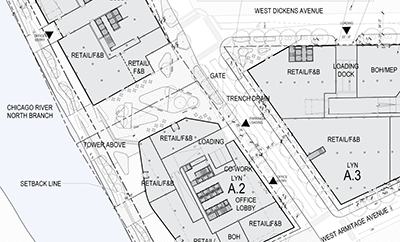
Excerpt from the proposed Lincoln Yards North ordinance, showing a site plan for
Subarea A. Source: city of Chicago.
In the master plan to which Hopkins referred, Sterling Bay lays out the building locations, building heights, streetscapes, and artist renderings for much of what it envisions for all 54 acres of Lincoln Yards.
But most of this detail doesn't appear in the proposed ordinances that the city recently released—and the ordinances are the only things that legally obligate Sterling Bay with respect to Lincoln Yards, regardless of any publicly-released master plan.
The ordinances—upon which the City Council might soon vote—don't include details about the 3,500 residential units that Sterling Bay has proposed for Lincoln Yards North, and the 2,500 units it's proposed for Lincoln Yards South. That's because construction of the associated buildings would occur subsequent to Lincoln Yards Phase 1, and only Phase 1 is detailed in the ordinances.
The proposed ordinances show, for the first time—in what Hopkins has called a "process that started in 2013"—detailed site plans for parts of Lincoln Yards.
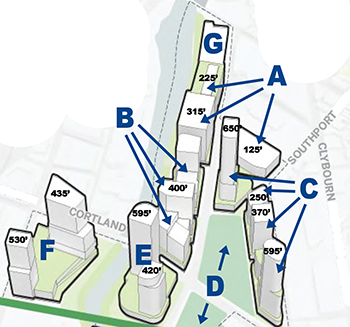
Proposed Lincoln Yards North subareas. Source: city of Chicago, Sterling Bay.
The city's development rules require a developer to submit, for any "residential component," details about unit sizes, including the "number of bedrooms and unit square footage projections." But because Lincoln Yards North Phase 1 construction contains no residences, this detail doesn't appear in the ordinances.
The proposed ordinances, though, do show the number of dwelling units, and how many units will end up in particular sections—called "subareas"—of Lincoln Yards.
For example: Lincoln Yards Phase 1 construction will take place in the northwest corner of the complex, in what the accompanying ordinance calls Subarea A. According to the proposed Lincoln Yards North ordinance, all the residential units will eventually be built to the south, in Subareas C, E, and F.
But maybe not.
The ordinance appears to contain wiggle room: language that lets Sterling Bay switch some or all of the dwelling units between subareas.
Here's how: Each ordinance contains 21 statements (summary here) that lay out obligations for things like affordable housing and minority contractors. Statement 16 says that "the Applicant may allocate or assign the development rights under the Planned Development to and among the designated subareas including, but not limited to, floor area and . . . dwelling units."
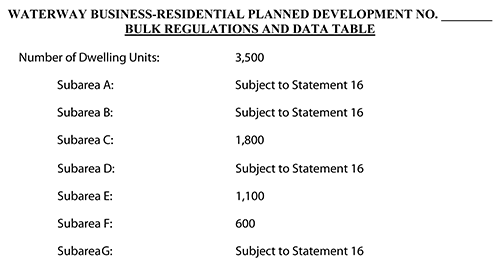
Excerpt from the proposed Lincoln Yards North ordinance, showing variability in
the number of dwelling units for parts of the complex called Subareas A, B, D, and G.
Source: city of Chicago.
When asked if this lets Sterling Bay move units between subareas, planning department spokesman Pete Strazzabosco said he wasn't sure—but, he said, this seems the most likely interpretation.
The Plan Commission's OK on Jan. 24 cleared the way for Lincoln Yards North and Lincoln Yards South to advance to Chicago's City Council: first, to the council's zoning committee; then, if passed by the committee, to the entire council for final approval.
The full council may approve the Lincoln Yards ordinances via a simple majority vote.
However, city law says that council approval could require a two-thirds vote—if "the property owners of land immediately touching, or immediately across a street, alley, or public way from at least 20 percent of the perimeter of the land" file a "valid written protest."


